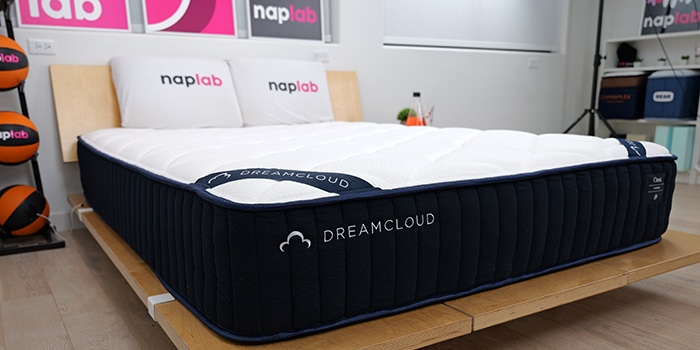
Best For
- Low levels of motion transfer, only 6.79 m/s²
- Faster material response time
- Budgets under $700 for a queen mattress
Considerations
- Pressure relief is good, but not great—only 3.5″ comfort layer
- Cooling is good, but not incredible
- Takes slightly longer to off-gas than average
Our Verdict
The DreamCloud Hybrid mattress is a 12.5″ hybrid mattress made of memory foam, poly foam, pocketed coils, and a quilted cover.
The DreamCloud Hybrid is available in a single firmness level — medium-firm. It is designed to appeal to a wide range of sleeper types, with an ultra budget-friendly price.
This mattress has deep sinkage and moderate levels of bounce. The deep sinkage and foam comfort layers do contribute to the mattress sleeping a little warmer than average (but it’s nothing extreme).
In our performance tests, this mattress earned an overall score of 8.66, ranking the mattress in the bottom 49% of all mattresses tested to date, compared to other hybrid mattresses tested. While the score isn’t particularly impressive, the price certainly is.
The DreamCloud Hybrid is $649 for a queen-sized mattress, which is 55% below average. This is a significant difference, saving sleepers $862 compared to the average hybrid mattress. While the performance isn’t exactly incredible, the price certainly is, making the DreamCloud an incredible value for the money.
Type: Hybrid
Firmness: Medium-Firm (6)
Best For: All Sleeping Positions, All Body Weights
In This Review
Performance Tests | Firmness | Support & Sleeping Positions | Design | Materials | Comparisons | FAQs
Performance Tests
At NapLab, we put each mattress to the test.
We test 10 different factors that impact the performance, comfort, and feel of the mattress. We then take the results of those tests and compare them to every mattress we’ve tested to date.
Check out the full performance table below to see how this mattress ranks:
| Factor | DreamCloud Hybrid | Average |
|---|---|---|
| Overall Score | 8.66 | 8.55 |
| Price (Queen) | $649 | $1,511.97 (Hybrid only) |
| Cooling – Score | 8.0 | 8.6 |
| Sinkage – Depth | 2.48″ | 2.18″ |
| Sinkage – Feel | Deep | Moderate |
| Motion Transfer – Score | 9.2 | 8.2 |
| Motion Transfer – Acceleration | 6.79 m/s² | 8.64 m/s² |
| Response Time – Score | 9.3 | 8.8 |
| Response Time – Mostly Recovered | 0.3 sec. | 0.4 sec. |
| Response Time – Fully Recovered | 0.6 sec. | 1.0 sec. |
| Bounce – Height | 9.05″ | 9.15″ |
| Bounce – Feel | Moderate | Moderate |
| Edge Support – Score | 8.9 | 8.6 |
| Edge Support – Sitting | 3.25″ | 4.00″ |
| Edge Support – Lying | Good | Good |
| Sex – Score | 8.5 | 8.3 |
| Pressure Relief – Score | 8.0 | 8.7 |
| Comfort Layer Thickness | 3.5″ | 4.1″ |
| Mattress Thickness | 12.5″ | 12.2″ |
| Off-Gassing – Score | 8.1 | 8.2 |
| Off-Gassing – Smell | Strong | Strong |
| Off-Gassing – Days | 7 days | 7 days |
| Company – Score | 10 | 8.8 |
| Trial | 365 nights | 170 nights |
| Warranty | Lifetime | 41% have lifetime warranties, average of other 59% of mattresses is 13 years |
How is DreamCloud Hybrid Different?
The DreamCloud Hybrid is a 12.5″ hybrid mattress with an overall performance level that is just barely above the average and a price tag that is significantly less than average—58% less than the average hybrid ($1,511).

Advantages
Beyond price alone, other advantages for the DreamCloud Hybrid include lower levels of motion transfer, faster material response time, and better edge support. This mattress only has 3.25″ of sinkage when seated at the edge, where 4.0″ is the average.
The sex score is also slightly higher than the average, which can be advantageous for couples. Lastly, the DreamCloud offers a 365-night trial period and lifetime warranty.
Neutral Factors
This mattress has deep sinkage and a moderate level of bounce. If you like engagement without too much pushback, the Dreamcloud Hybrid could be a solid option.
Disadvantages
Cooling is decent (8.0), but still below the average performance score (8.6). The deeper sinkage can leave sleepers feeling a little warm as well. This mattress also has below-average pressure relief, a score of only 8.0 compared to the average score of 8.7.
Cooling Test
The DreamCloud Hybrid has good cooling. During our tests, I felt a slight level of heat retention, but it was nothing extreme.
Baseline Temp.
75.9° F
Max. Temp.
92.0° F
Ending Temp.
80.6° F
This mattress uses a hybrid design with layers of poly foam and memory foam on top of a pocketed coil unit. The memory foam is infused with gel, which certainly helps with the total cooling performance.
In addition, having memory foam below a quilted cover helps, as positioning the memory foam so it’s not in direct contact with the sleeper’s body helps better resist heat.
Max. Temp.
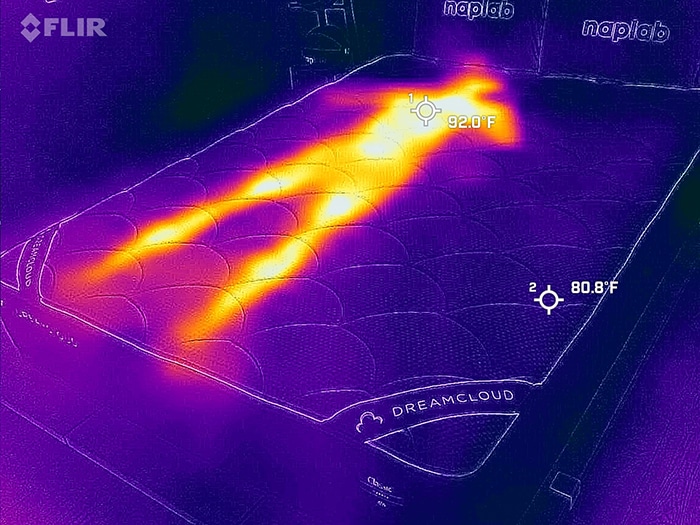
Ending Temp.

- Baseline Temperature – the temperature of the mattress before anyone lies on it
- Maximum Temperature (0 minute) – the temperature of the mattress after lying on it for 15 minutes
- Ending Temperature (5 minute) – the temperature of the mattress after being lied upon and having no one on it for 5 minutes
Dreamcloud’s product page states that the mattress utilizes cooling fibers within the cover. However, in our testing, I didn’t feel that these fibers were making a substantial impact on cooling. The cover did not have a cooling feel to it.
In our objective temperature tests, we measured a max surface level temperature of 92.0° F. This is 2.2° warmer than the average of 89.8° F, based on all of our tests to date.
After getting off the mattress, the temperature declined by 7.3° from minutes 0 to 1, which is 2.6° cooler than the average 0 to 1 minute decline of 4.7°.
Heat Dissipation Over Time
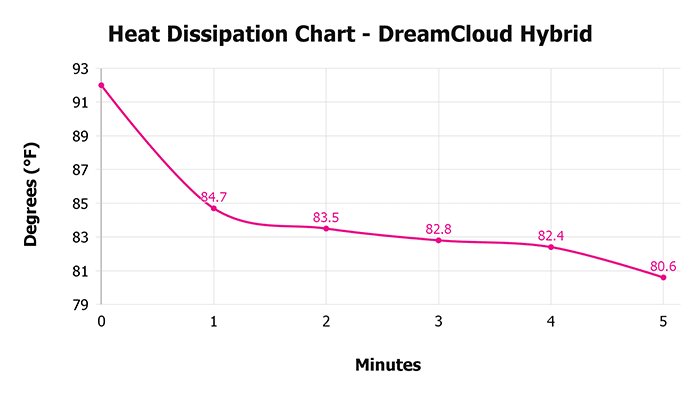
When we consider the combination of objective data, my subjective experiences, and an analysis of the materials, I’m confident in my view that cooling is good.
Sinkage Test
The DreamCloud Hybrid has deep sinkage. During our tests, we measured a pressure point sinkage depth of 2.48″. This is 0.30″ more sinkage than the average sinkage depth of 2.18″, based on all of our tests to date.
Sinkage Depth
2.48″
Sinkage Feel
Deep
Body Contour
Balanced
The level of sinkage is documented in the image below.

The mattress creates a balanced body contouring hug. If we look at the material design, that balanced hug makes sense. We have a mix of quilted cover, memory foam, and poly foam, which creates a more even and less polarizing feel.
The mattress rebounds back to shape quickly, which helps avoid any type of a stuck feeling. Overall, this feels like a good quality hybrid design for mass appeal.
It has reasonable sinkage, a medium-firm firmness, and a more responsive feel. The reliance on poly foam instead of memory foam creates a less dramatic hug around the body.
Motion Transfer Test
The DreamCloud Hybrid has a very low level of motion transfer. During our tests, we measured a total acceleration range of 6.79 m/s². This is 21% less motion transfer than the average of 8.64 m/s².
Accel. Range
6.79 m/s²
Motion Duration
0.92 seconds
The Dreamcloud’s motion transfer benefits from the below-average level of bounce, which means there is simply less energy returned by movements on the mattress.
In addition, the 1.0” memory foam layer beneath the quilted cover seems to be absorbing a ton of energy also. This combination results in a below-average level of motion transfer.
The level of motion transfer is also documented in the video below.
In our motion transfer chart, which visualizes our accelerometer data, we can see the highest motion peaks from 0 to 0.14 seconds. Motion declines thereafter, but remains modest until it returns to near-zero levels by 0.92 seconds.
Motion Transfer Over Time
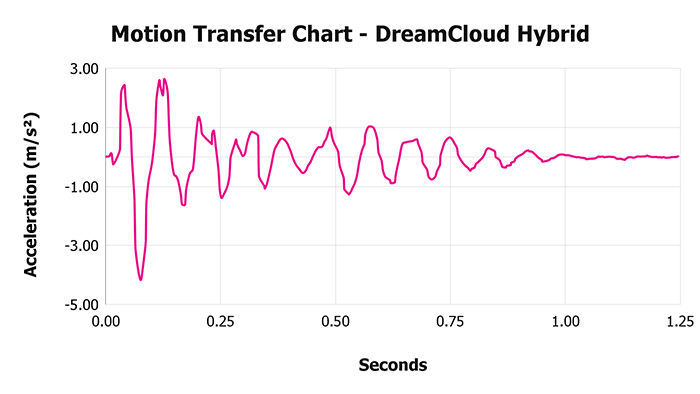
While I was pleased with the motion intensity, I’m not thrilled by the 1-second motion duration. That’s worse than average and the fact it remains at a fairly moderate level from 0.14 to 0.92 seconds isn’t ideal.
Nevertheless, overall motion transfer is low and given the low intensity, I don’t expect motion transfer will be an issue for most sleepers.
Response Test
The DreamCloud Hybrid has a very fast material response. In our mostly recovered test, we measured a recovery speed of 0.3 seconds, which is 0.12 seconds faster than the average of 0.42 seconds, based on all of our tests to date.
Mostly Recovered
0.3 sec.
Fully Recovered
0.6 sec.
In our fully recovered responsiveness test, we measured a recovery speed of 0.6 seconds, which is 0.38 seconds faster than the average of 0.98 seconds. The comfort material within the mattress is mostly poly foam.
The level of responsiveness is documented in the video below.
We have a 1.5” quilted cover with poly foam, a 1.0” memory foam layer, and another 1.0” poly foam. These poly foam layers are highly responsive and spring back to their original shapes quickly.
The 1.0” memory foam layer is a bit slower, but even there, it’s fairly quick to return to its original shape. The faster-than-average responsiveness ensures the mattress is easy to move around.
In addition, it does not create a dramatic or overly enveloping hug around the body, which further helps to improve ease of movement and avoid a stuck feeling.
Bounce Test
The DreamCloud Hybrid has a moderate level of bounce. During our tests, we measured a total bounce height of 9.05″. This is 0.10″ less bounce than the average of 9.15″, based on all of our tests to date.
Max. Depth
5.27″
Max. Rebound
3.78″
Total Bounce
9.05″
While we do have less bounce than average, it’s still within the moderate bounce range. This more moderate bounce is due to the medium-firm feel, reliance on poly foam instead of memory foam, and thinner-than-average comfort layer.
Max. Sinkage Depth

Max. Bounce Height

The level of bounce is also documented in the video below.
While bounce is preferential to a degree, in general, having more is typically more beneficial. The moderate bounce ensures the mattress is easy to move around and sex is not significantly negatively impacted.
Edge Support Test
The DreamCloud Hybrid has excellent sitting edge support and good lying edge support.
Max. Sinkage
3.25″
Lying Support
Good
Reinforced Edge
Yes
In our sitting edge support test, we measured a sitting sinkage compression of 3.25″. This is 0.75″ less sitting sinkage than the average of 4.00″, based on all of our tests to date.
The level of edge support while seated is documented in the images below.
Sitting, 140 lbs.
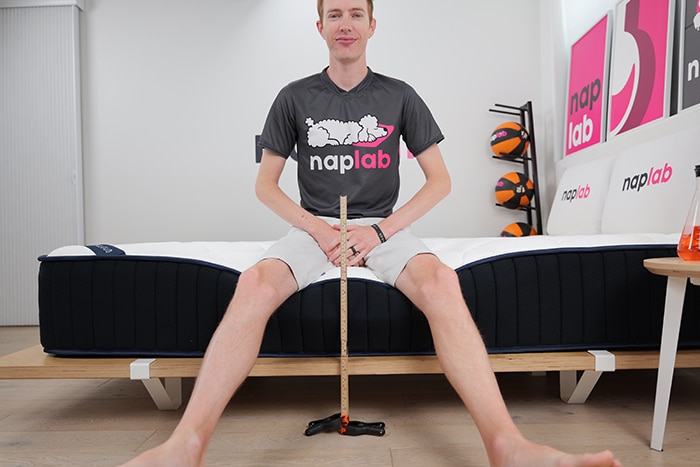
Sitting, 200 lbs.
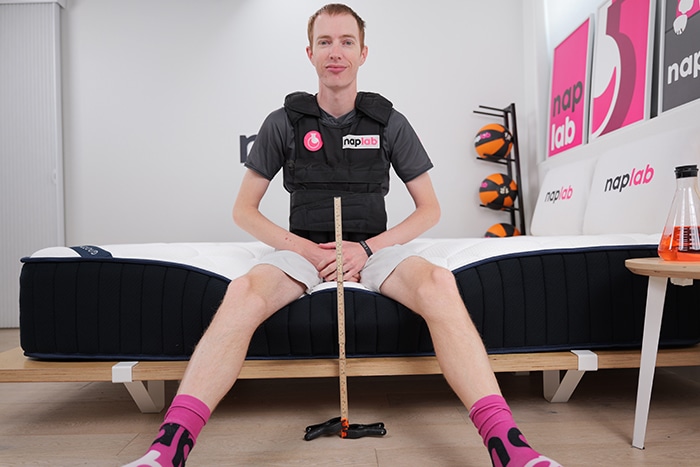
Edge support while lying wasn’t quite as good, but it’s not bad either. While lying directly on the edge of the mattress, I felt that the support was good in all sleeping positions.
The level of edge support while lying is documented in the images below.
Lying on Edge, 140 lbs.
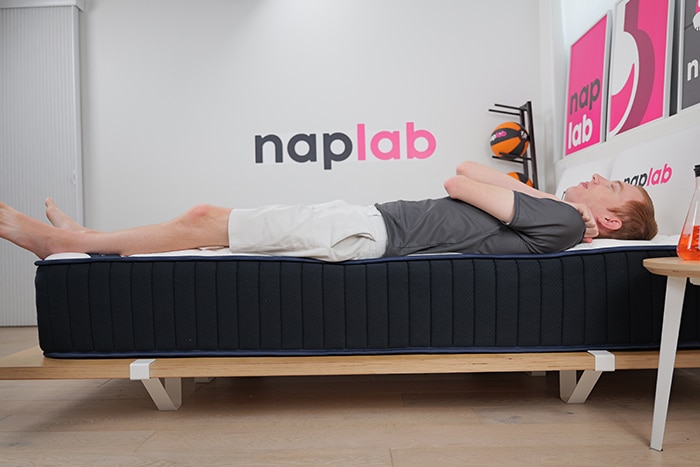
Lying on Edge, 200 lbs.
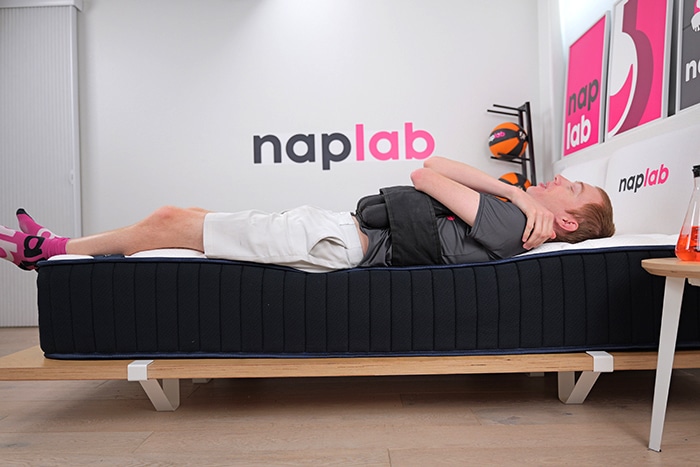
The Dreamcloud uses reinforced edge support coils that run along the entire perimeter of the mattress. These coils have a notable impact on both sitting and lying edge support. That said, I do think there is room for improvement with respect to the lying edge support.
The thinner-than-average comfort layer and material quality aren’t exactly incredible, and in my view, these factors are limiting the lying edge support.
That said, and to be fair, this is an incredibly budget-friendly hybrid at $649 for a Queen. This level of edge support performance is more than reasonable for this price.
Sex Test
The DreamCloud Hybrid has good sex performance. On the positive side, noise is minimal and edge support for sitting is quite robust.
There is just 3.25” of sitting edge support. Having a fairly robust edge extends the usable surface area of the mattress.

Moving on, we have our last 3 factors, all of which have good performance, but a performance level that isn’t amazing either. Pressure relief and cooling are both good. Lastly, bounce came in at 9.05”, which is slightly below average.
| Sex Factor | Factor Weight | Score | Rating |
|---|---|---|---|
| Bounce | 65% | 8.1 | High |
| Edge Support | 20% | 9.7 | Excellent |
| Noise | 5% | 10 | Minimal |
| Pressure Relief | 5% | 8.0 | Good |
| Cooling | 5% | 8.0 | Good |
When it comes to sex, more bounce is always better and ideally I want to see 10” or more.
The limited bounce is helping to keep motion transfer lower, but it’s also the primary reason that sex performance only earned a good score and not a great one.
Pressure Relief Test
The DreamCloud Hybrid has a good level of pressure relief. During our tests, I felt no significant pressure points on my body.
Comfort Layer
3.5″
Support Layer
9.0″
The mattress is comfortable, and yet, it’s clear there is room for improvement. The mattress is equipped with 3.5″ of comfort material, which is 0.63″ less comfort material than the average comfort layer thickness of 4.13″, based on all of our tests to date.
The foam quality is fine and exactly what I expect and is appropriate for a mattress at this price point. Even so, the foams are far from amazing.
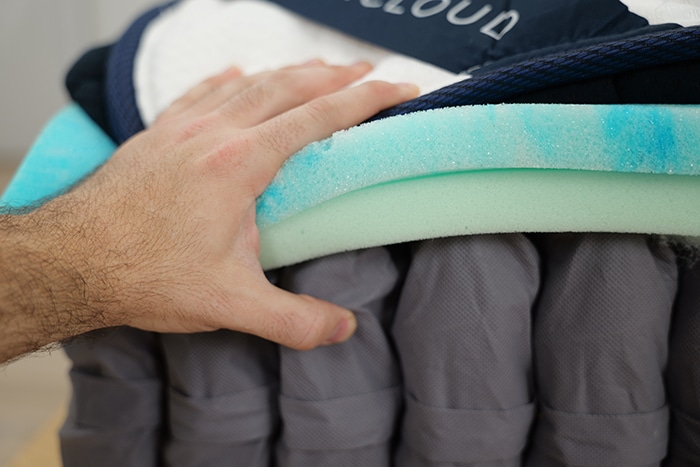
In my view, the thinner-than-average comfort layer combined with the relative middling foam quality is limiting the total pressure relief performance. The combination of memory foam and poly foam creates a more balanced feel and avoids any type of dramatic hug or contour.
In our pressure mapping tests, we measured a max PSI of 0.50. This is well within the low-pressure range we want to see (a high-pressure point is a 2.0 PSI).
Pressure Map – Side Sleepers
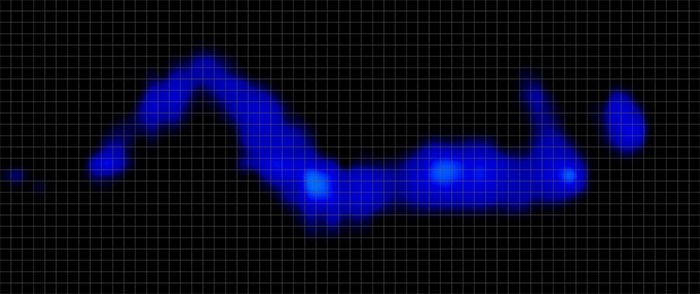
| Pressure Relief (PSI) | Average | Maximum |
|---|---|---|
| Side Sleepers | 0.14 | 0.50 |
Pressure Map – Back Sleepers
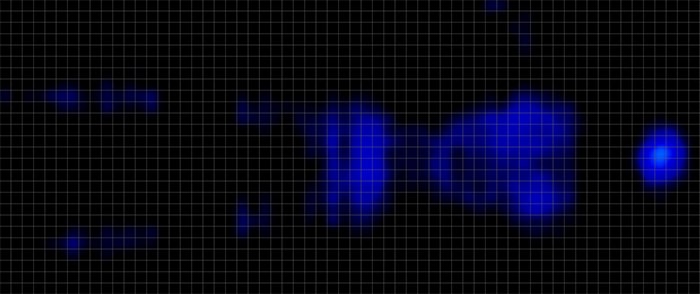
| Pressure Relief (PSI) | Average | Maximum |
|---|---|---|
| Back Sleepers | 0.07 | 0.48 |
Pressure Map – Stomach Sleepers

| Pressure Relief (PSI) | Average | Maximum |
|---|---|---|
| Stomach Sleepers | 0.08 | 0.48 |
When I consider our objective pressure mapping tests, material thickness, material quality, and my subjective experience on the mattress, I’m confident most sleepers will find the pressure relief to be good.
Off-Gassing Test
The DreamCloud Hybrid had a strong smell upon the initial unboxing. The mattress smelled for 7 days. This is 0.5 days longer than the average smell duration of 6.5 days.
Initial Smell Strength
Strong
Off-Gassing Period
7 days
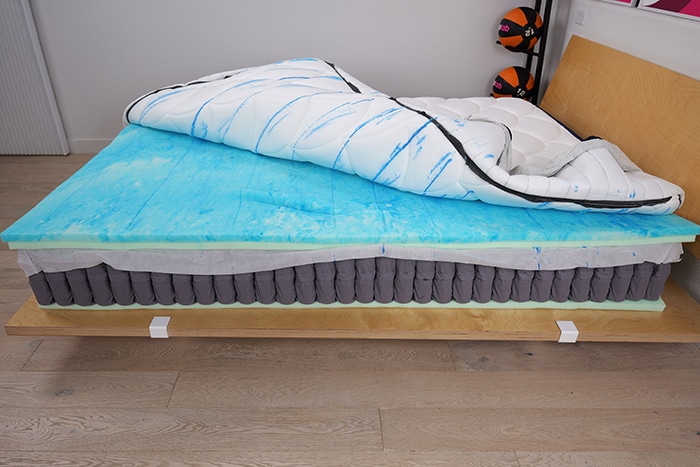
Company
Being a sister brand to Nectar, DreamCloud mimics the terms and conditions of Nectar mattresses. It offers a 365-night trial and a lifetime warranty. Shipping and returns are both free.
| Company Factor | Factor Weight | Score | Data |
|---|---|---|---|
| Returns | 40% | 10 | $0 |
| Trial Period | 30% | 10 | 365 nights |
| Warranty | 20% | 10 | Lifetime |
| Shipping | 10% | 10 | $0 |
| Country of Origin | 0% | USA |
Comparing 100+ brands tested to date, the average trial period is 170 nights, so DreamCloud’s 365-night trial is notably more than the average. DreamCloud also offers a lifetime warranty, an advantage only offered by 39% of all mattresses we test.

How firm is DreamCloud Hybrid?
The DreamCloud Hybrid is available in a single firmness, medium-firm, coming in as a 6 out of 10 on the firmness scale.

This feel is generally suitable for a wide range of sleepers.
Support & Sleeping Positions
Support on the DreamCloud Hybrid is excellent. During our tests, I felt well supported in all sleeping positions.
| Support Factor | Data |
|---|---|
| Comfort Layer | 3.5″ |
| Support Layer | 9.0″ |
| Firmness | Medium-Firm |
| Body Contour | Balanced |
| Zoned Support | No |
| Reinforced Edge | Yes |
The mattress is equipped with a 9.0″ support layer. This is 1.07″ thicker than the average support layer thickness of 7.93″, based on all of our tests to date.
For a mattress to create ideal support, it needs to keep the spine in alignment, while also providing sufficient comfort. While pressure relief performance isn’t incredible, it’s good enough, especially at this price point.
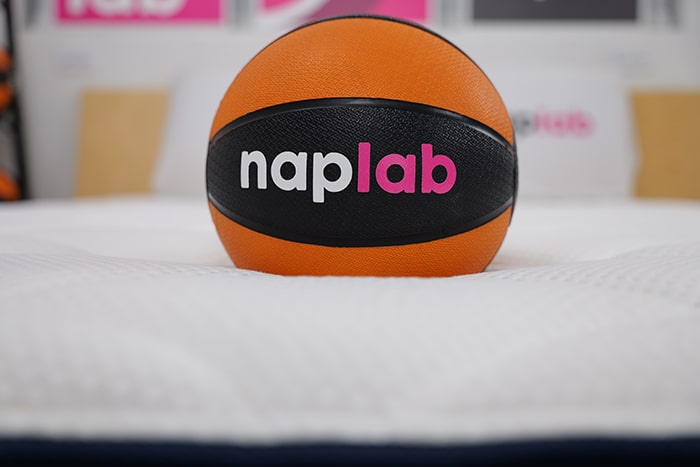
Check out the table below to see the sleeper weights and sleeping positions that would be best suited for this mattress.
| Sleeper Weight | Stomach Sleeper | Side Sleeper | Back Sleeper |
|---|---|---|---|
| Under 150 lbs. | Yes | Yes | Yes |
| 150-250 lbs. | Yes | Yes | Yes |
| 250-300 lbs. | Yes | Yes | Yes |
The medium-firm feel and moderate to deep sinkage creates an appropriate support dynamic for most body types (up to 300 pounds) and sleeping positions.
This mattress does not use any type of zonal support, which isn’t ideal and yet, it would be wholly unreasonable to expect it to at this price point.
Based on all of my tests to date, an analysis of the materials, and my subjective experiences, I’m confident most sleepers will find support on the DreamCloud Hybrid is excellent.
Design
The DreamCloud Hybrid is a 12.5″ hybrid mattress that comes in a single firmness option—Medium-Firm. It is designed as a budget-friendly hybrid mattress with a simpler design and an attractive price point.
| Design Factor | Data |
|---|---|
| Type | Hybrid |
| Thickness | 12.5″ |
| Cover Type | Quilted |
| Weight | 79 lbs. |
| Has Handles | No |
| Fiberglass-Free | Yes |
| Ships in a Box | Yes |
For sleepers who want a hybrid but also want to stay below $700, the DreamCloud Hybrid certainly fits the bill.

Materials
The DreamCloud Hybrid is 12.5″ thick and contains a combination of memory foam, poly foam, pocketed coils, and a quilted cover. From top to bottom, here is a full list of the materials used in this mattress:
| Layer Type | Thickness | Layer Specs |
|---|---|---|
| Quilted Cover | 1.5″ | Not Available |
| Memory Foam | 1.0″ | Not Available |
| Poly Foam | 1.0″ | Not Available |
| Pocketed Coils | 8.0″ | Not Available |
| Support Foam | 1.0″ | Not Available |
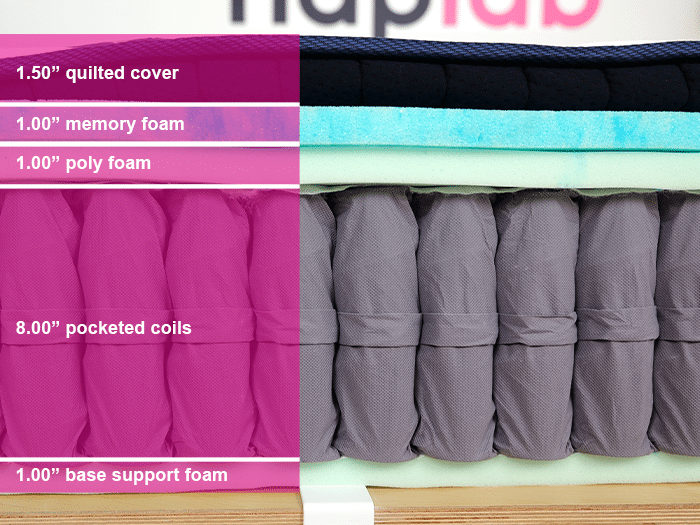
The Law Tag outlines the full breakdown of materials included in this mattress.
- Materials
- 100% polyurethane foam pad
- Outer cover:
- 71% polyester
- 17% viscose
- 4% polyethylene
- 4% barrier coating
- Made By: Ashley Furniture Industries LLC, 234 Turner Industrial Park Road, Saltillo, MS 38866
- Date of Delivery: Blank
- Finished Size: 60.00” x 80.00”
- Net Weight of Filling Material: Blank
- Made In: USA
- Manufactured By: Ashley Furniture Industries LLC, 234 Turner Industrial Park Road, Saltillo, MS 38866
- Date of Manufacture: 03/2025
- Hybrid Mattress Cover: 01.20.2025
- Model: M13531
- Prototype ID: 24DCHM135
The Cover
The DreamCloud Hybrid has a quilted cover with a soft feel and a good amount of stretch to it. It has scalloped stitching that gives the mattress a modern look.
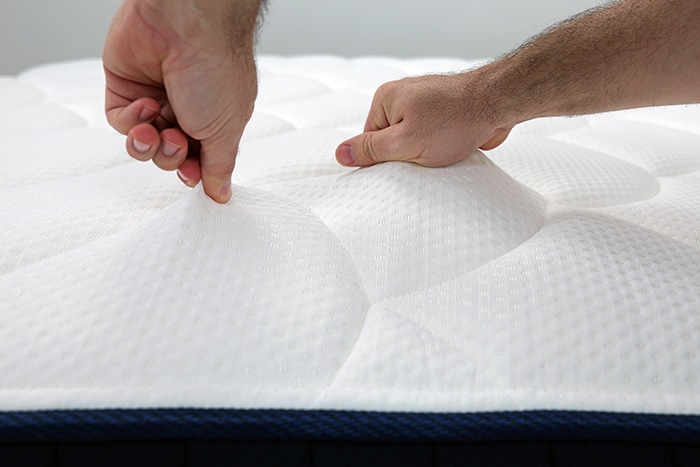
The Comfort Layer
The comfort layer is 3.5″ thick and made of memory foam and poly foam. Directly beneath the quilted cover is a 1.00″ memory foam (blue foam). This material is helps to create more hug and body contouring.
Beneath that is a 1.00″ poly foam (light green foam). This foam is a firmer poly foam and begins to transition bodies into the support layers below.

These two layers combined give the DreamCloud Hybrid a 3.5″ comfort layer thickness (if we include the quilted cover). The average comfort layer thickness is 4.1″, so the DreamCloud is notably thinner.
The Support Layer
The support layer is 9″ thick and made of pocketed coils and a layer of support foam on the base, each coil individually encased in a thin fabric.
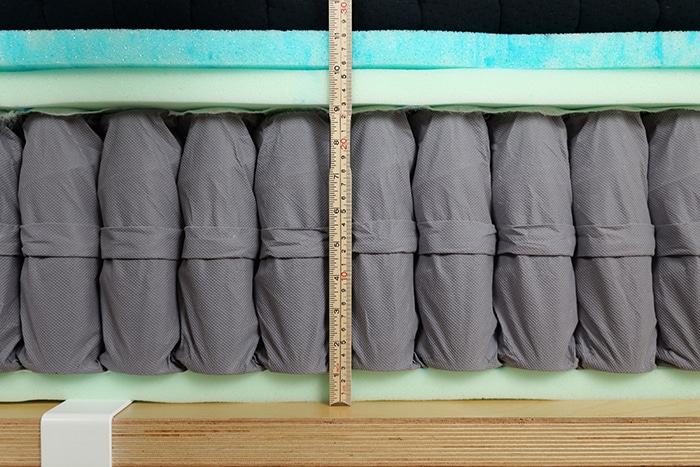
Lastly, let’s talk about the base of the mattress. Under the coils is a simple 1.0″ support foam. The main role of this foam is to support the layers above and also provide stability to the base of the mattress.
Product Evolution
DreamCloud came from the same makers of the Nectar mattress, with Nectar launching in 2017 and DreamCloud following shortly after in 2018.
DreamCloud offers a collection that includes hybrid mattresses as well as memory foam mattresses.
We tested the DreamCloud Classic Hybrid back in 2021 (which was sold from 2021 to 2024) and then did a re-test 2025. In 2025 Dreamcloud completely redesigned their mattress and brought manufacturing back to the US (as they were recently acquired by Ashley Sleep).
The table below highlights the differences between these two mattresses.
Here’s a comparison of the 2021 version compared to the 2025 version.
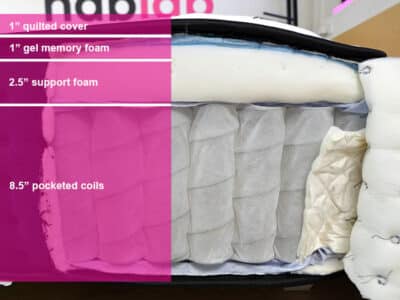
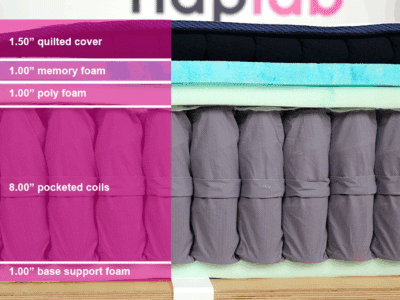
| Specs | 2021 Version | 2025 Version |
|---|---|---|
| Overall Score | 8.37 | 8.66 |
| Thickness | 14″ | 14″ |
| Firmness | Slightly Firm (7) | Medium-Firm (6) |
| Cover | Quilted Cover | Quilted Cover |
| Comfort Layer | 1.0″ Quilted cover 1.0″ Gel Memory Foam 2.5″ Support Foam | 1.5″ Quilted Cover 1.00″ Memory foam 1.00″ poly foam |
| Support Layer | 8.5″ Pocketed Coils | 8.0″ Pocketed Coils 1.0″ Support Foam |
As the table above shows, the changes made between 2021 and 2025 ultimately resulted in a better-performing mattress.
Beyond performance being better, both the material quality and build quality comparing the new 2025 Dreamcloud Hybrid to the old version is significant. The earlier Dreamcloud struggled on performance in large part due to a material quality that felt lower quality and lacking. Even the build quality wasn’t great.
By contrast, the new DreamCloud Hybrid (now manufactured by Ashley Sleep within the US) feels like a significant step up. Even a visible side-by-side assessment shows the difference in quality, consistency, material cuts, and layer stack.
As a result, it was no surprise to see the performance jump considerably for the new 2025 version.
Overall, I’m really pleased with the new mattress, the materials, the build quality, and the fact that manufacturing is now within the US. For $649, the DreamCloud Hybrid feels like a very solid value.
Other Mattresses to Consider
Still not sure if the DreamCloud is the best option for you? Check out the recommendations below for three other top-performing hybrid mattresses under $1,000 you may want to consider.
For Performance
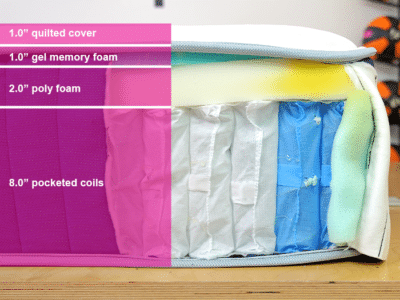
Glacier Original
A Great Value Pick
The Glacier is a high-performing 12″ hybrid mattress with a medium-firm feel. This mattress has moderate sinkage, low bounce, and a value-packed price. While the sticker price can’t beat the price of the DreamCloud, it is still under $800 and has better overall performance than DreamCloud.
For Side Sleepers
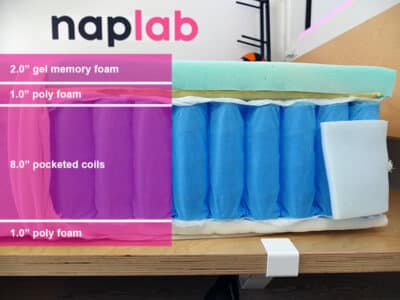
Zoma Hybrid
Deep Sinkage
The Zoma Hybrid is a 12″ hybrid with higher overall performance than the DreamCloud Hybrid. This mattress has deep sinkage, moderate bounce, and exceptional pressure relief, making it a good option for side sleepers, especially.
For Pressure Relief
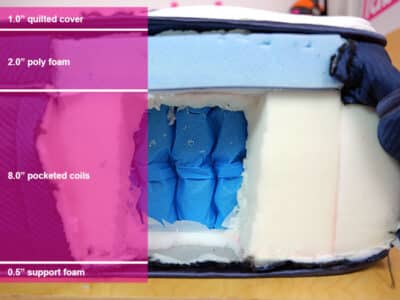
Silk & Snow Hybrid
Memory Foam Comfort Layer
The Silk & Snow Hybrid is an 11.5″ hybrid with a medium-firm feel. This mattress has deep sinkage and high bounce, with a 3.0″ comfort layer. It has a modern memory foam feel, with a hybrid pocketed coil base. Priced at $800, this is another great value pick for sleepers on a budget, although not quite at the same price point as DreamCloud.
Frequently Asked Questions
Still have questions? Check out some of the top FAQs on the DreamCloud Hybrid mattress below and get the answers you’re looking for.
Here are the current prices, with any sales or promotions reflected below:
Twin: $399
Twin XL: $549
Full: $579
Queen: $649
King: $849
Cal. King: $849
*Note: Sales prices are subject to change without notice or warning.
The purchase of any DreamCloud mattress comes with a 365-night trial period, a limited lifetime warranty, and free shipping to your door. If you decide that the mattress isn’t right for you, they offer free returns.
Yes, DreamCloud mattresses are sold in numerous retailers around the USA. You can find DreamCloud’s store locator here.



